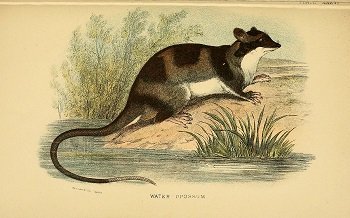
Now, if you’re picturing a yapok swimming around like a pro, you’re not wrong! These creatures are known for their unique adaptations that help them thrive in aquatic habitats. But just how intelligent are they? The truth is, understanding the yapok’s smarts can give us a window into how animals adapt and survive in diverse environments. Let’s break down their cognitive abilities and behavior, and see what makes the yapok stand out in the animal kingdom.
What Exactly Is a Yapok?
Yapoks, or *Chironectes minimus*, are small, semi-aquatic marsupials found primarily in South America. They weigh about 2 to 4 pounds and have a body length of about 15 inches. With their waterproof fur and webbed feet, these little swimmers are masters of their aquatic environment. Picture them gliding through rivers and streams, foraging for food with surprising agility.
But it’s not just their physical traits that make them interesting. Yapoks are part of the family of marsupials, which means they give birth to underdeveloped young that continue growing in their mother’s pouch. This unique reproductive trait is a fascinating aspect of their biology that ties into their overall adaptability and survival skills.
Yapok’s Cognitive Skills: An Overview
When we talk about intelligence in animals, we’re often looking at problem-solving abilities, social learning, and even memory. Yapoks are known for their ability to use their environment to find food and create nests. They typically eat insects, crustaceans, and aquatic plants, which requires a fair amount of skill in navigating their surroundings.
Imagine a yapok rummaging through the mud to find a tasty snack. This behavior shows not only their foraging skills but also their adaptability to challenges in their environment. These mammals have developed behaviors that help them thrive in different settings, whether it’s under water or on land.
Problem Solving and Learning Capabilities
So, how do yapoks tackle problems? One interesting aspect is their hunting technique. They often dive underwater to catch prey, which requires both strategy and skill. Research shows that yapoks demonstrate a level of **problem-solving** when foraging. They can remember the locations of food sources and return to them repeatedly, indicating a form of spatial memory.
You might find it fascinating to think about how similar this is to how we remember where we left our keys or which grocery stores have the best deals. This kind of learning is crucial for survival in the wild, as it helps them efficiently gather food without wasting energy.
Social Behavior and Communication
Yapoks are generally solitary animals, but they do communicate with each other, especially during mating season. They use a variety of sounds and scents to convey their presence and intentions. It’s like they have their own chat room, albeit one that’s a bit quieter than ours.
Their social structure might not be as complex as that of monkeys or wolves, but their ability to interact with each other shows that they have some social intelligence. Understanding how to signal to another yapok can be the difference between finding a mate or spending a lonely night.
Adaptability in Changing Environments
You might be wondering why adaptability matters for the yapok. Well, in today’s world, many habitats are under threat from climate change and pollution. Yapoks have shown resilience in shifting their behaviors and habitats in response to environmental changes.
They are often found in diverse habitats, from flooded forests to rivers. Their ability to adjust to different food sources and environments speaks to their overall intelligence. Think of it like a skilled chef who can whip up a meal with whatever ingredients are available—you have to be smart and flexible!
Yapok vs. Other Animals: A Comparative Look
When we look at intelligence across the animal kingdom, it can be useful to compare yapoks to other creatures. For instance, they are often compared to otters, which are also semi-aquatic. While otters are known for their playfulness and social structures, yapoks tend to be more solitary and focused on survival.
The differences in their behavioral patterns highlight how various species develop intelligence suited to their needs. While otters might excel in social intelligence and cooperative hunting, yapoks showcase remarkable individual problem-solving skills and adaptability in their environment.
Why Understanding Yapok Intelligence Matters
So, what’s the takeaway from learning about yapok intelligence? Understanding their cognitive abilities not only highlights their uniqueness but also sheds light on broader ecological themes. How animals adapt and survive is critical knowledge, especially as we face environmental changes that threaten many species.
By studying the yapok, researchers can gain insights into the importance of habitat conservation and the relationship between cognition and survival. It reminds us that every species has a role to play in our ecosystem, and protecting them is crucial for maintaining ecological balance.
In conclusion, the yapok may be small, but it packs a punch when it comes to intelligence and behavior. Their adaptability, problem-solving skills, and social interaction provide a fascinating glimpse into the mind of this unique marsupial. So, the next time you hear about these little creatures, you’ll know just how smart they really are!
